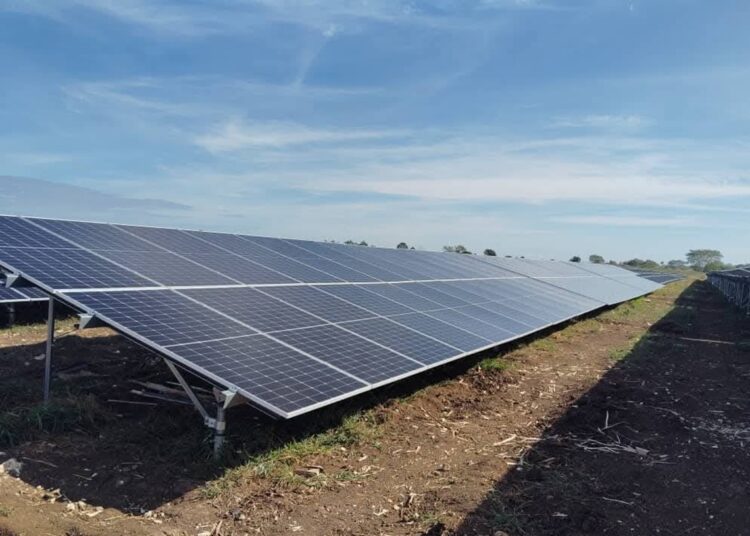Cuba’s new solar parks are in the public eye. These installations, presented with great fanfare by authorities and official media, are currently causing questioning and dissatisfaction among the people amid the island’s prolonged energy crisis.
And with good reason. The announcement of this important investment and, above all, the long-awaited launch of the first parks, raised the expectations of a population that for months has been suffering endless blackouts, which, moreover, are severely punishing the depressed Cuban economy.
However, with the fourth month of 2025 ticking away on the calendar and eight of the new photovoltaic panel installations already operational, those expectations are far from being met. Power outages continue to be rampant on the island, with 20 or more consecutive hours of blackouts in many places.
The situation is such that authorities have been forced to temper their optimism and dampen public expectations, with explanations in which they have emphasized the now irreplaceable role of the long-standing thermoelectric plants and have once again pointed to U.S. sanctions as the “main cause” of the crisis.
What does the new solar park project currently underway consist of? What is its real impact on Cuba’s electric power system? Are these parks the desired solution to the blackouts? We will attempt to answer these questions based on what has been said so far by officials and official media.
Parques fotovoltaicos: Un remiendo rumbo a la solución de una crisis
The project: how and until when?
The installation of the new solar parks was announced a year ago by Minister of Energy and Mines Vicente de la O Levy. At the time, the official explained that it consisted of two contracts with Chinese companies, which together would gradually contribute more than 2,000 MW to the electric power system (SEN).
These agreements, De la O explained to Prensa Latina (PL) news agency, contemplated the installation of 46 solar parks each, approximately three in each province. The sum of the two provides a total of 92 new parks, whose completion dates were planned — according to the official report at the time — for May 2025 and 2028. Each of them, as explained, has a capacity of 21.8 MW.
However, while the final number of these parks has remained unchanged in official reports, the dates have changed. In September, Rosell Guerra, director of renewable energy at the Ministry of Energy and Mines (MINEM), stated that work was already underway at some 30 locations and that the goal was to install 10 of these parks by the end of 2024, equivalent to approximately 220 MW. We now know that this did not happen.
Just a month later, the director general of the Electricity Conglomerate (UNE), Alfredo López, in statements to Granma newspaper, reduced the number of parks that were then “in different stages of construction” to 26, without mentioning start-up dates.
Meanwhile, Lázaro Guerra, director general of electricity at the MINEM, confirmed that there are actually two projects and extended their time horizon by several years. “The first project will allow for the installation of 1,000 MW over a two-year period; the second project, with the same generation capacity, should be ready by 2031,” the press release stated, citing the official’s statement.
Since then, official reports have indiscriminately given 2025 and 2026 as the final years for the first project and 2028 and 2031 as the closing date for the second, fueling the confusion. There has even been some journalistic reports suggesting the completion of all 92 parks has been moved up to next year.
The minister appears to have resolved the inconsistency a few days ago in a lengthy interview with Granma, in which he attempted to weather the wave of public doubts and questions. De la O Levy, who had already announced in Parliament in December his intention to install 55 parks by 2025, confirmed that one of the projects and part of the other, which would extend until 2031, were to be finalized this year.
“It was always said that it was a contract that would be received in seven years, and that they would arrive in the first year,” the head of MINEM stated regarding the second project. “Along with that contract, another 1,000 MW contract was signed that would arrive immediately. Therefore, in one year we have the 1,000 MW, plus a ‘piece’ of the other, one-seventh of the other contract. And in addition, we have others in our country,” he added.
First solar park connected in project to curb energy crisis in Cuba
Until December and until now
In his interview with Granma, De la O Levy denied that the overall investment had been delayed due to difficulties in assembling the parks, although he acknowledged delays in the arrival of some components and the complexity of the logistics and construction of these facilities, which, he assured, is progressing according to schedule.
If all goes according to plan, 55 of the 92 solar parks included in the two agreements with China should be installed by the end of 2025. Or at least more than 50, according to Ovel Concepción, director of renewable energy generation at MINEM, who rounded up — and downplayed — the number in a recent Mesa Redonda TV program.
Last December, the minister announced that starting in March, an average of five parks would be operational per month, an estimate reiterated this week by Lázaro Guerra in a television appearance. For his part, President Díaz-Canel recently indicated that by the end of the first half of the year, installed capacity would be 560 MW, which means that 26 parks should be operational by then.
In any case, what official forecasts agree on is that by the end of this year, new parks should total more than 1,000 MW, a significant figure considering that last September, before the commissioning of the first facilities of this project, photovoltaic generation in Cuba only reached 286 MW, according to Rosell Guerra.
Of that number, by the end of March and so far in April, about 170 MW have been installed, that is, eight parks. To give you an idea, the figure is equivalent to the capacity of the 100 MW Mariel unit, along with a smaller one similar to those at Renté in Santiago de Cuba, as noted by the Cubadebate website a few days ago.
For now, it is not an impressive figure. The Guiteras and Felton 1 units, the two workhorses of thermal generation in Cuba, each have a larger capacity, exceeding 200 MW, despite the logical limitations due to overexploitation and the longevity of their technology.
The first two parks, in Havana and Cienfuegos, synchronized with the SEN (National Electric Power System) in late February. Six others did so in the third month of 2025, and none have done so in the fourth month, although at least one of the six connected in March — the one in Ciego de Ávila — was officially inaugurated in early April.
The operation of these parks, according to authorities, is progressing well. “The parks have synchronized on the planned dates and are delivering the energy as planned,” stated the general director of electricity at the MINEM. According to Guerra, those eight parks are producing about 1,000 MWh* per day, although that contribution actually fluctuates from day to day — this Thursday, for example, it was only 797 MWh — and “is not that linear.”
Previously, Ovel Concepción had stated that the first two installed parks were operating “very well” and were generating between 120 and 140 MW. This, he said, had resulted — around March 20 — in “savings of more than 1,000 tons of fuel, which have not needed to be used in power generation.”
If, in the opinion of the authorities, the installation and energy contribution of the new solar parks is progressing positively, why has their impact not yet been felt in the island’s bleak outlook? Is it just because of their low number so far? Will it be felt at some point? Will the parks be able to contribute beyond daylight hours?
We will address these concerns in a future article on the topic.
* MW is not the same as MWh. UNE has explained that the first indicator refers to the capacity to generate or consume energy in one hour. Therefore, the new solar parks can produce up to 21.8 MW per hour each, and combined with the eight already in operation, they can exceed 170 MW in that time.
On the other hand, MWh is the total energy generated in a given period. In the aforementioned case, that period is one day. Therefore, the 1,000 MWh referred to by Lázaro Guerra, as he says, represents the combined production of the eight parks on an average workday.











Bring in Chinese engineers. They will have it working in no time.
What is total electricity comsumption in Cuba in 2019 and how much of this will these 50 initial solar parks provide? At peak use period, say 4-6pm, how much of that demand will 50 solar parks parks provide?